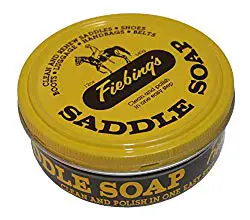Restoring leather tack can be quite a lot of work. But the sense of accomplishment you will get every time you use that gear on your rides is worth every bit of elbow grease.
A few years back my wife and I went to an auction not too far from our home. We love going to auctions, especially ones with barns full of tack! We wanted to go to this auction to pick up some new hay rings on the cheap. Anyway, we ended up befriending a very nice man who was a scrapper. This nice guy ended up winning all of the contents of this barn. Mountains and mountains of stuff. Think hoarders but with about an inch of dust and mouse droppings on everything. Not to make the story drag on, we ended up helping him go through this barn. As he was only interested in items with lots of metal in them. We were able to salvage a huge pile of very dried out bridles, a full set of driving tack, leads, etc. Every one of these was not suitable to be used for more than decoration. But I saw the potential and thought to myself “How can I restore these?”
Restoring leather tack comes down to careful cleaning and a lot of elbow grease. Aside from that, it’s about replacing what has broken from its years of neglect. Clean, Repair Protect.
Clean before Restoring
The first step to restoring any leather tack is to carefully clean the item. This will test your patience, you will need to be very thorough, and very careful. Be sure to note any places that have mold, these will need further attention later. You do not want to use any heavy chemicals on the surfaces of the leather tack.
Leather, at one point in its life, was skin. Leather is tanned and stained a particular color. Using harsh chemicals on the leather isn’t going to bring it back to its original state. You need to use a product specifically designed to not only clean but nourish.
Without a doubt, one of my favorites for this is saddle soap, it does an awesome job removing some of the grime and leaves the leather feeling a lot less brittle. I have an in-depth article on the benefits of saddle soap here.
Start with a clean dry rag and soft bristle brush. Get every bit of dust and cruft off of the leather before using any cleaner. All of that dust and gunk would just cake up in your brush or rag and either smear or worse, scratch the surface.
Next, use a damp rag to further remove any dust or debris left of the surface of the leather. Make sure to remove any buckles or metal items that you can so that they are out of the way. Also, get all of the edges and use a toothbrush to get into any tight places. Allow the leather tack to dry completely before moving onto the next step.
Repair Leather Tack
In some cases that you will have to repair holes in the leather or even rips, and some of the metal components on the item may not be usable anymore. It won’t do you a lot of good to restore a beautiful halter only to have rusted metal clasps.
In some cases, the metal components can be removed from the leather, cleaned, wire-brushed, and eventually polished to a nice shine. However, in many cases, it might just be easier and safer to look for the necessary item on Amazon or your local farm store and just replace it altogether.
Cleaning metal components can be quite a chore and as I mentioned earlier sometimes it’s not that safe. Rust is like cancer to metal, it slowly eats away at the metal. In the case of many components found on our everyday tack, this corrosion could cause the part to fail. I can say from experience that being caught out on a long trail ride with equipment that has failed is not a situation that you want to experience. My wife and I were out on a beautiful ride at Big Valley Ranch when one of my lead clips snapped due to my horse stepping on it while I had hopped off to stretch. Yes, I could have avoided this by having my wife hold the reins but hindsight is 20-20 right? Anyway, with about 50mi of trails and down one lead the amazing day turned sour pretty quick.
As for repairing leather components, similar principals apply. Some parts may be stitched or glued back together. But in some cases it will pay off, in the long run, to just replace the part.
I don’t really want to fix it: Who can I call?
This question can be a little bit tricky as a lot of it depends on your situation. In my small town of about 5000 people, we actually have this awesome gentleman who specializes in repairing cowboy boots and leather tack. Try to do a search in your local area for “saddle repair” or “Leather Repair” most larger cities should have one of these and if they can’t help you I would wager that they will be able to send you in the right direction for your area.
Hydrating Leather Tack
Next, with a fresh rag begin to rub the saddle soap into the leather. Remember the goal here is to nourish the leather. Much like applying lotion to your own skin, the saddle soap should disappear as you rub it into the leather. I like to use circular patterns and pretend I’m the star of a big karate movie. Wax on, Wax Off.
Undoubtedly, there will be a few spots where you have some excess soap. Be sure to take another clean, dry rag and wipe this away. Some of the ingredients in saddle soap can be harmful to horses if they were to ingest it. Again, the idea is to work the soap into the pores of the leather not put a topcoat on. Additionally, these spots would dry into a white crusty residue. When you restore leather tack you wouldn’t want it to not be beautiful when you’re done right?
Post restoration care: Keeping leather looking great!
In order to keep your restored leather tack looking great, you will need to do a little bit of continual maintenance. Conditioning leather using a leather conditioner replaces the tanning oils that are depleted over time through moisture, heat, and wear. Reconditioning leather every so often, about every 6-9 months, ensures that it never becomes stiff, dry, or cracked again.
A leather conditioner is necessary for this step. There are hundreds of products available for this task. Do your research so you won’t need to restore the leather tack all over again. One of my good friends who happens to be a master leatherworker, although, he won’t admit it, swears by beeswax. It’s all-natural and does an awesome job conditioning the leather.
To conclude, having the skillset to restore neglected leather tack is a great way to save some cash on your ranch. But I’ll be the first to admit that it can be a very time-consuming endeavor.

